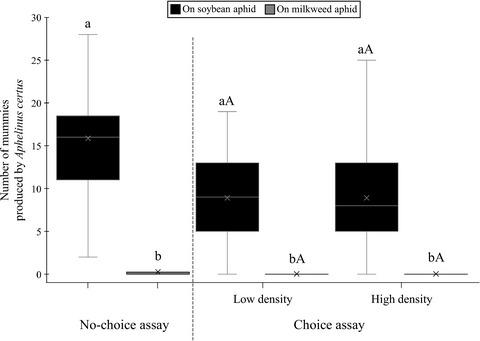当前位置:
X-MOL 学术
›
Ecol. Evol.
›
论文详情
Our official English website, www.x-mol.net, welcomes your
feedback! (Note: you will need to create a separate account there.)
Parasitoid‐mediated indirect interactions between unsuitable and suitable hosts generate apparent predation in microcosm and modeling studies
Ecology and Evolution ( IF 2.3 ) Pub Date : 2021-02-23 , DOI: 10.1002/ece3.6896
Lucie S Monticelli 1, 2 , Nicolas Desneux 1 , George E Heimpel 3
Ecology and Evolution ( IF 2.3 ) Pub Date : 2021-02-23 , DOI: 10.1002/ece3.6896
Lucie S Monticelli 1, 2 , Nicolas Desneux 1 , George E Heimpel 3
Affiliation

|
Parasitoids used as biological control agents often parasitize more than a single host species and these hosts tend to vary in suitability for offspring development. The population dynamics of parasitoids and hosts may be altered by these interactions, with outcomes dependent on the levels of suitability and acceptance of both host species. Parasitism of individuals of an unsuitable host species may indirectly increase populations of a suitable host species if eggs laid into unsuitable hosts do not develop into adult parasitoids. In this case, the unsuitable host is acting as an egg sink for parasitoids and this can reduce parasitism of suitable hosts under conditions of egg limitation. We studied parasitoid‐mediated indirect interactions between two aphid hosts, Aphis glycines (the soybean aphid) and A. nerii (the milkweed, or oleander aphid), sharing the parasitoid Aphelinus certus. While both of these aphid species are accepted by A. certus, soybean aphid is a much more suitable host than milkweed aphid is. We observed a drastic reduction of parasitoid offspring production (45%) on the suitable host in the presence of the unsuitable host in microcosm assays. Aphelinus certus females laid eggs into the unsuitable hosts (Aphis nerii) in the presence of the suitable host leading to egg and/or time limitation and reduced fitness. The impact of these interactions on the equilibrium population sizes of the three interacting species was analyzed using a consumer–resource modeling approach. Both the results from the laboratory experiment and the modeling approaches identified apparent predation between soybean aphid and milkweed aphid, in which milkweed aphid acts as a sink for parasitoid eggs leading to an increase in the soybean aphid population. The presence of soybean aphids had the opposite effect on milkweed aphid populations as it supported increases in parasitoid abundance and thus reduced the fitness and abundance of this aphid species.
中文翻译:

寄生物介导的不合适和合适宿主之间的间接相互作用在微观世界和模型研究中产生明显的捕食
用作生物防治剂的拟寄生物通常寄生多个宿主物种,并且这些宿主对后代发育的适宜性往往有所不同。寄生蜂和宿主的种群动态可能会因这些相互作用而改变,其结果取决于两种宿主物种的适宜性和接受程度。如果产在不合适宿主体内的卵没有发育成寄生蜂成虫,那么对不合适宿主物种的个体的寄生可能会间接增加合适宿主物种的种群数量。在这种情况下,不合适的宿主充当寄生蜂的卵池,这可以减少合适宿主在卵限制条件下的寄生。我们研究了寄生蜂介导的两种蚜虫寄主,大豆蚜虫和蚜虫之间的间接相互作用。 nerii (马利筋,或夹竹桃蚜),共享寄生蜂Aphelinus certus 。虽然这两种蚜虫都被A接受。 certus 中,大豆蚜是比马利筋蚜更合适的寄主。我们在微观分析中观察到,在不合适宿主存在的情况下,合适宿主上的寄生蜂后代产量急剧减少(45%)。在存在合适宿主的情况下,雌性Aphelinus certus会将卵产到不合适的宿主( Aphis nerii )中,导致产卵和/或时间限制以及适应性降低。使用消费者资源建模方法分析了这些相互作用对三个相互作用物种的平衡种群规模的影响。 实验室实验和建模方法的结果都确定了大豆蚜虫和马利筋蚜虫之间存在明显的捕食关系,其中马利筋蚜虫充当寄生蜂卵的水槽,导致大豆蚜虫种群的增加。大豆蚜虫的存在对马利筋蚜虫种群产生相反的影响,因为它支持寄生蜂丰度的增加,从而降低了该蚜虫物种的适应性和丰度。
更新日期:2021-03-21
中文翻译:

寄生物介导的不合适和合适宿主之间的间接相互作用在微观世界和模型研究中产生明显的捕食
用作生物防治剂的拟寄生物通常寄生多个宿主物种,并且这些宿主对后代发育的适宜性往往有所不同。寄生蜂和宿主的种群动态可能会因这些相互作用而改变,其结果取决于两种宿主物种的适宜性和接受程度。如果产在不合适宿主体内的卵没有发育成寄生蜂成虫,那么对不合适宿主物种的个体的寄生可能会间接增加合适宿主物种的种群数量。在这种情况下,不合适的宿主充当寄生蜂的卵池,这可以减少合适宿主在卵限制条件下的寄生。我们研究了寄生蜂介导的两种蚜虫寄主,大豆蚜虫和蚜虫之间的间接相互作用。 nerii (马利筋,或夹竹桃蚜),共享寄生蜂Aphelinus certus 。虽然这两种蚜虫都被A接受。 certus 中,大豆蚜是比马利筋蚜更合适的寄主。我们在微观分析中观察到,在不合适宿主存在的情况下,合适宿主上的寄生蜂后代产量急剧减少(45%)。在存在合适宿主的情况下,雌性Aphelinus certus会将卵产到不合适的宿主( Aphis nerii )中,导致产卵和/或时间限制以及适应性降低。使用消费者资源建模方法分析了这些相互作用对三个相互作用物种的平衡种群规模的影响。 实验室实验和建模方法的结果都确定了大豆蚜虫和马利筋蚜虫之间存在明显的捕食关系,其中马利筋蚜虫充当寄生蜂卵的水槽,导致大豆蚜虫种群的增加。大豆蚜虫的存在对马利筋蚜虫种群产生相反的影响,因为它支持寄生蜂丰度的增加,从而降低了该蚜虫物种的适应性和丰度。































 京公网安备 11010802027423号
京公网安备 11010802027423号